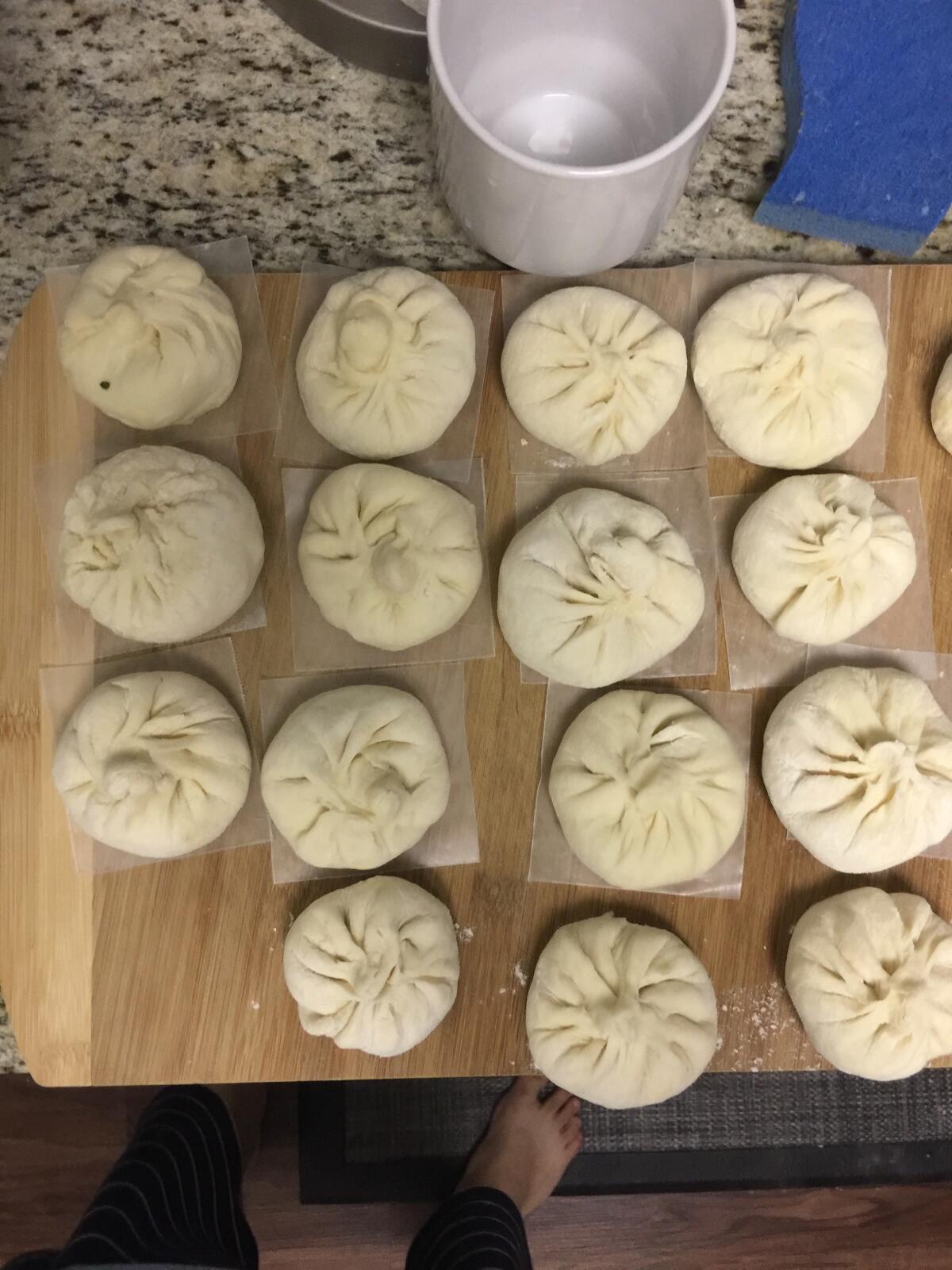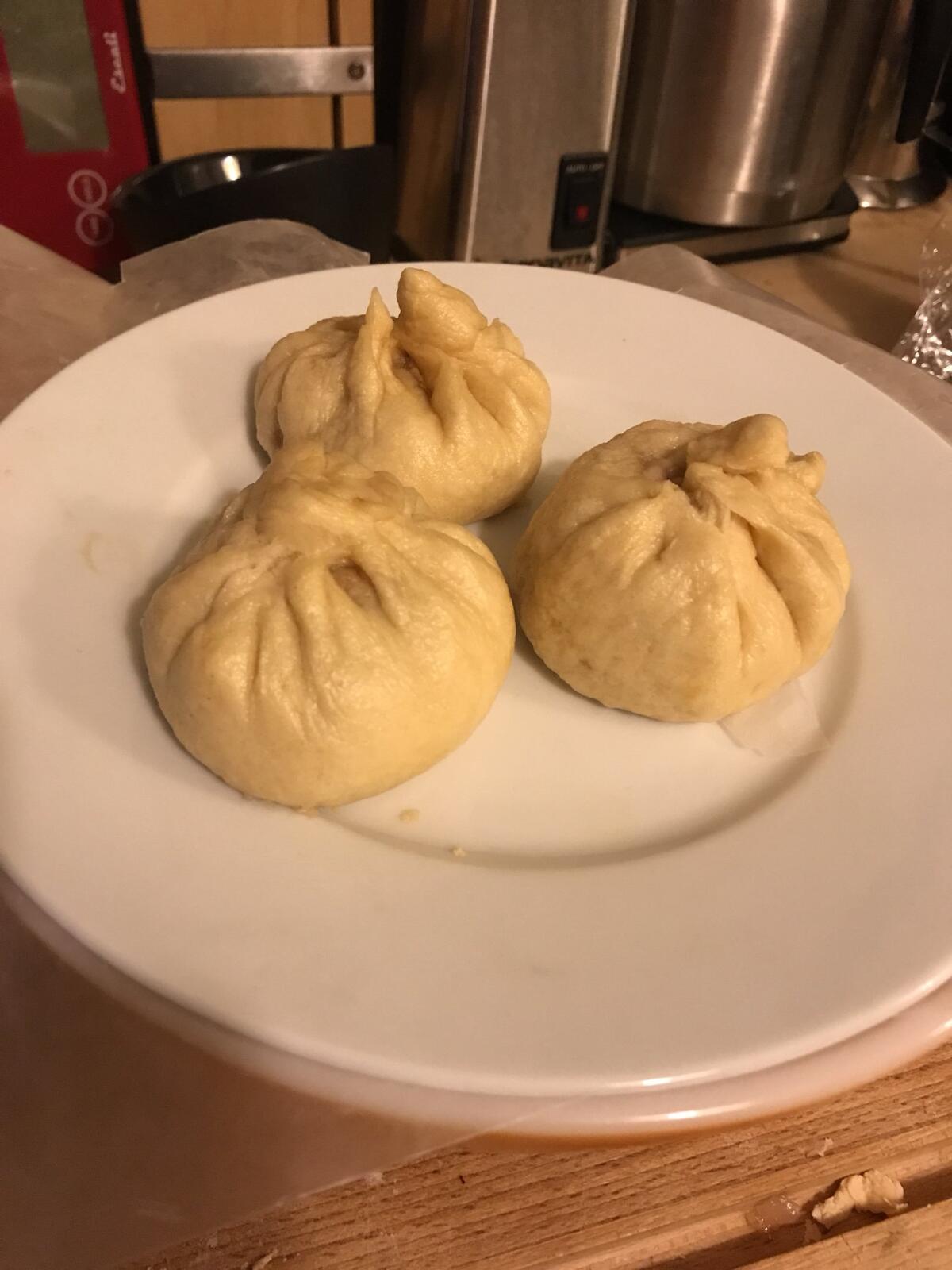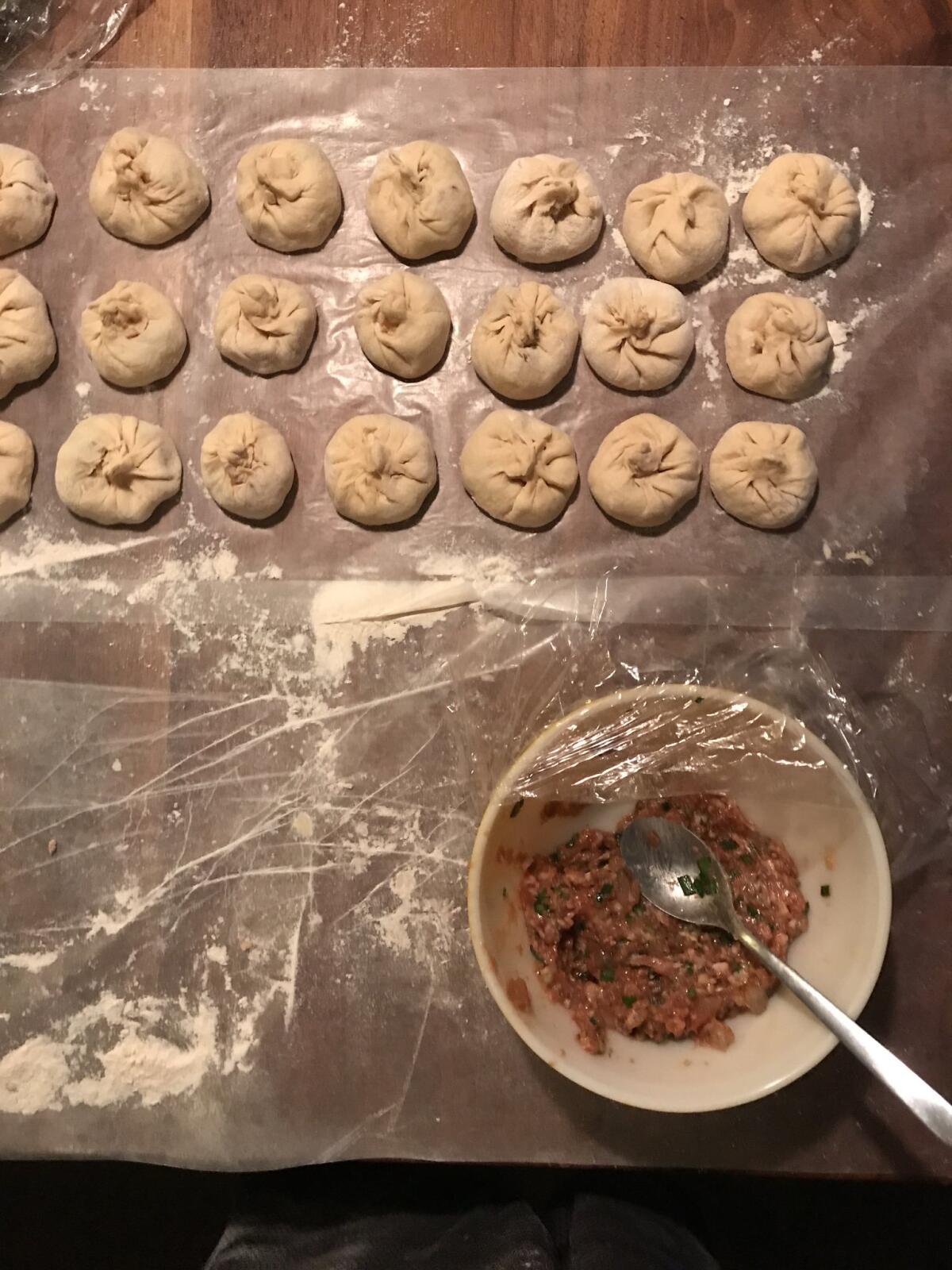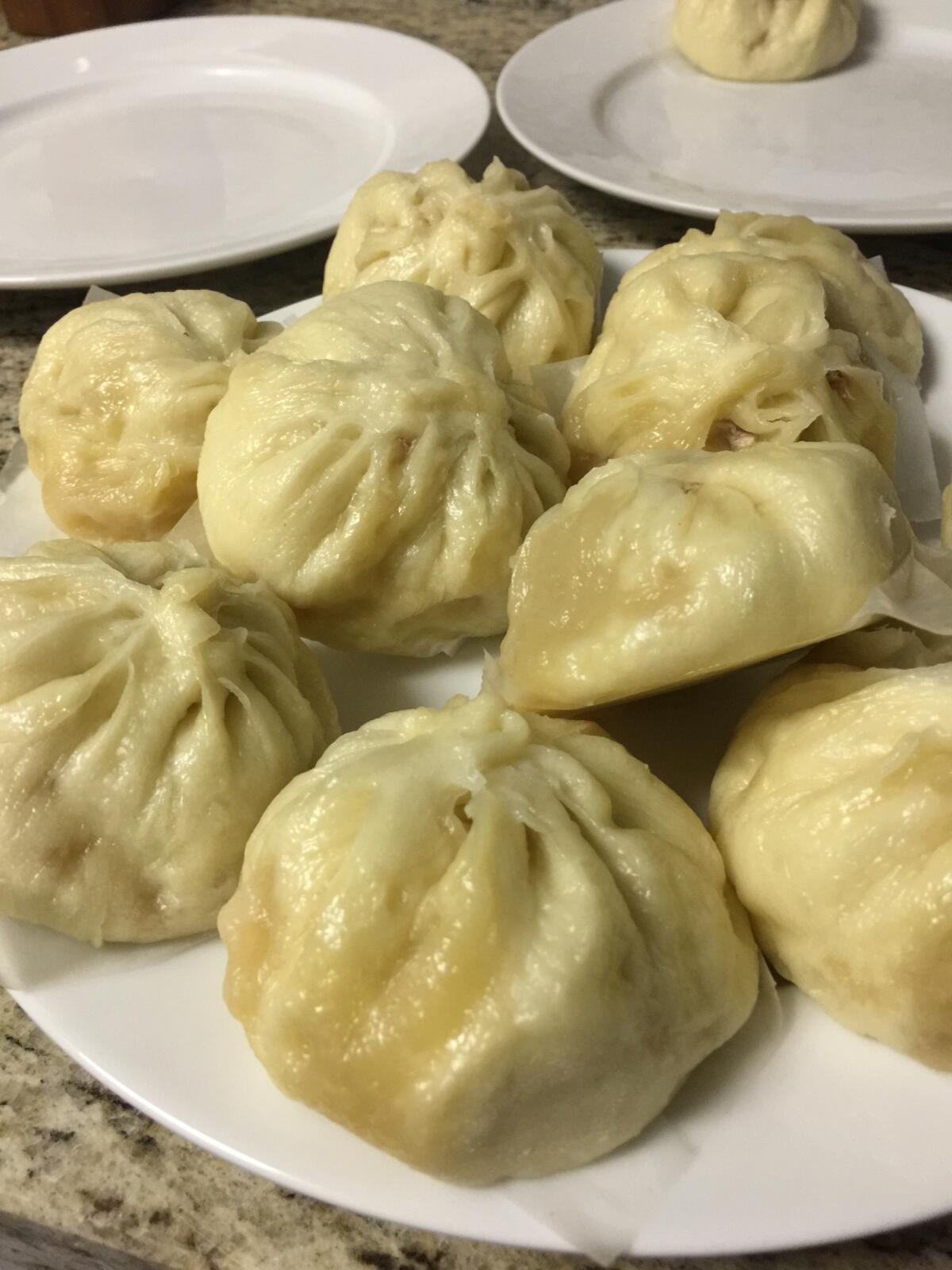Column: On Thanksgiving, my Taiwanese family makes baozi. One day I asked my father why
- Share via
In a Chinese meal, typically one of the first decisions you make is about the starch.
There are buns, pancakes, rice, noodles, dumplings, doughnuts, breads, buns and baozi, but often it boils down to a choice between rice or flour.
We eat both rice and flour in my family, but we’ve always had a predilection for flour. Making baozi is our main tradition during Christmas and Thanksgiving.
It’s pretty easy to start. We add water to flour to make dough, then add yeast to help it rise. After a few hours, we take the dough out, douse it in flour and roll it into a thin log.

Then my father passes the log through his hand, using his encircled thumb and forefinger like a cigar cutter to pinch the dough into tiny buns. I roll the buns into the doughy moons that end up as the bao’s wrapper. We dab a mixture of ground pork, soy sauce, rice wine vinegar (or rice wine), nappa cabbage and chives (or green onions) onto the wrappers.
Next is the part I always mess up. We slowly rotate the baozi, twisting, pinching and cupping simultaneously so you end up with a round, sealed pouch that looks a bit like a plump, coiled flower bud — though mine often more closely resemble lumpy potatoes.
I never understood exactly why we made baozi. It’s common for a lot of Chinese cultures to eat flour-based products like breads, baozi and mantou at home, but I had rarely heard of other Taiwanese families doing it. It was time-consuming and difficult, like trying to perform a dough-based origami.
The baozi were delicious, but they were different, and that wasn’t what I wanted when I was growing up. As a Taiwanese kid in Tennessee, I hungered for turkey, stuffing, cranberry sauce and green bean casserole — or at least a Thanksgiving that somewhat resembled that of my friends.
One day I asked my dad why we make baozi during the holidays. And flour, it turns out, tells the story of my family.
My grandfather was a grain clerk who came over to Taiwan with the nationalist Chinese government after the communist revolution in 1949. His family couldn’t afford rice all the time, but he received flour allowances from work.
My grandmother made mantou with the flour and underwear with the sackcloth, which was 100% cotton and higher-quality fabric than the underwear they could buy. When they had meat, which wasn’t often, they made baozi.
My mother and father grew up during a time of unprecedented economic growth and societal change that economists called the Taiwan Miracle.

But the miracle’s price, in part, was paid in rice. Most domestically produced rice was exchanged for foreign currency in order to support the rapid industrialization of Taiwan’s economy. And rice production across Asia took a downturn following the revolution in China and the Korean and Indochina wars. Many in my parents’ generation grew up knowing the feeling of hunger.
Eating baozi and mantou, at the time, was a mark of poverty. When my dad opened his lunchbox at school, all the other kids would know that his family was too poor to afford rice.
In other words, baozi made him different, and different wasn’t what my father wanted to be at the time.
My mom told me a similar story last year.
She makes a dish I’ve never seen in a Chinese restaurant. It’s simple — cabbage sauteed with salt and pepper, with beaten eggs poured over it to form an omelet. Sometimes she adds pickled Chinese radishes or meat or whatever is in the fridge. It’s fast and satisfying, and keeps pretty well as leftovers.
She used to eat this omelet nearly every day as a child, so much that she grew to hate it. Money was scarce after my grandpa was hurt in a car accident. My grandma did odd jobs in exchange for rice and other food items. My mom and her five siblings worked as children to pay for school and food. One of their chores was to rummage in the garbage bins outside restaurants for scraps to feed their chickens.
And every day, when she opened her lunchbox at school, the omelet was there, taunting her.

But as an adult, she makes it regularly. It reminds her of her childhood. She calls it a hui wei, which literally translates to “return flavor.”
I was 30 years old when I heard these stories for the first time. I was struck by the irony that both my parents and I had grown up yearning for belonging, resenting the food of our families. And I’m continually surprised by how little I know about the people who raised me.
I don’t know how my parents met, or how my father charmed my mother, or what their families thought of each other, or what dreams they had as young adults.
I know only that my mother looks startlingly beautiful in the wedding photos that used to hang in their bedroom, and that my father looks so proud that his mouth appears too small to hold the teeth in his smile.
Growing up, I asked my parents about their past many times, but each question was like inserting a quarter in a broken payphone. Always, they answered in a way that acknowledged the question but provided no information.
But as an adult, the questions I asked as a child suddenly have different answers. And I’ve grown to see the holidays as a chance to reexamine the narratives we told ourselves about our families and our childhoods. Memories of hunger and longing can become celebrations of abundance. A single question can transform childhood resentments into precious markers of identity.

I grew up longing for my family to participate in American traditions. And as it turns out, our baozi tradition is fundamentally American in at least one way: The baozi and mantou my father grew up eating in Taiwan were made with American flour — donated by U.S. officials as part of an aid campaign. The cotton sacks that my grandmother sewed into my father’s underwear were stamped with the American flag.
So at the dinner table this Thanksgiving, if things get tense or the silences get long, here’s my advice: Ask your parents to tell you a story about the food they grew up eating.
Sometimes there’s a big story behind a simple choice between rice and flour.
More to Read
Sign up for Essential California
The most important California stories and recommendations in your inbox every morning.
You may occasionally receive promotional content from the Los Angeles Times.














